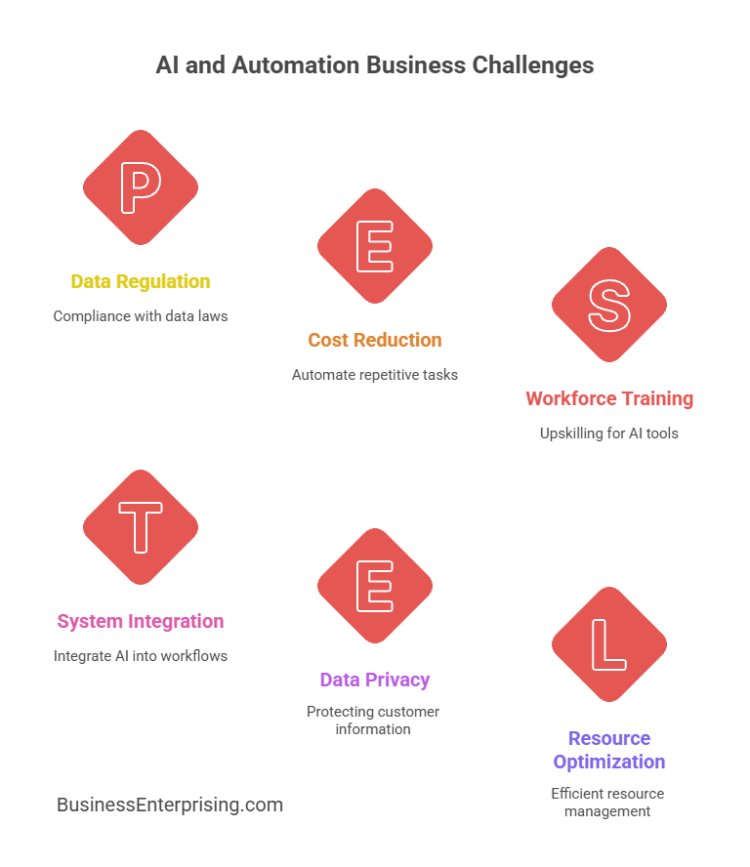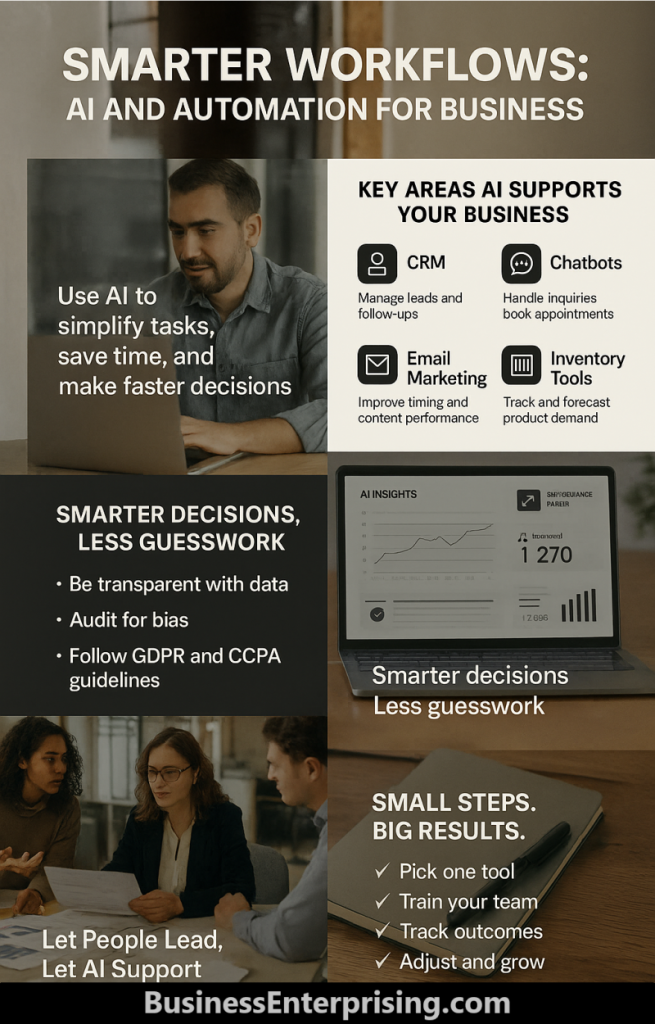
Many tasks that once needed manual effort can now run on autopilot. For example, email follow-ups, social posts, and lead tracking can happen without reminders. Additionally, AI can help write content, respond to messages, or review customer feedback. These features work quietly in the background but make a big difference.
You might already use some of these tools without thinking much about them. CRM systems, scheduling apps, and support chat all include smart functions. Therefore, adding more automation often starts by exploring what your tools already offer. Small adjustments can lead to better results with less effort.
Additionally, AI helps you make decisions based on real data. You can see trends, predict demand, and test new ideas faster. That gives you a better view of what’s working and where to improve. These insights are helpful when your time and budget are limited.
You don’t have to be technical to use these tools. Most platforms are built with small teams in mind. Therefore, you can start with simple steps and expand as your needs grow. With the right setup, AI becomes a support system, not a replacement.
Understanding the Role of AI in Modern Business Operations
Artificial intelligence is becoming part of everyday business operations. You may already use AI tools without realizing how much they handle behind the scenes. Many tasks that once required constant human input now happen automatically, saving you time and effort.
For example, businesses use AI to schedule meetings, manage emails, and route customer service inquiries. These systems process data quickly and respond without delays. Therefore, you no longer need to manually sort requests or monitor inboxes around the clock. As a result, your team can focus on higher-level work.
Additionally, AI supports better decisions by analyzing patterns in large sets of information. Sales trends, customer behavior, and inventory levels can be tracked and reported in real time. That gives you quick insights without needing a data analyst on staff. You can respond faster to changing conditions and make informed choices without waiting for monthly reports.
AI and automation for business also help with managing repetitive administrative tasks. Tasks like invoicing, expense tracking, and document processing can run in the background. These tools reduce errors and keep your business running smoothly. That consistency helps maintain reliable workflows without constant supervision.
You don’t need to overhaul your systems to benefit. Many cloud platforms already include AI features built into their software. Therefore, by using familiar tools more effectively, you can start making small improvements that add up over time. Technology will continue to evolve, but you can already see its practical value. When used with purpose, AI can support daily business needs without adding complexity. Start where it makes sense, and build from there.
Automation Tools That Save Time and Reduce Costs
If you spend too much time on repetitive tasks, automation can help. Tools now exist to manage daily business functions without manual work. You can automate tasks across marketing, sales, and support with very little setup.
Zapier and Make are two tools that connect your apps and create simple workflows. For example, you can send leads from your website straight to your CRM. Additionally, these tools can update spreadsheets, send emails, or create tasks automatically. That means fewer delays and less chance of something slipping through.
You can also use custom bots to support your customer service or sales teams. These bots respond to common questions, qualify leads, or send reminders. Therefore, your team can stay focused on tasks that require judgment or a personal touch. When bots handle routine steps, your process moves faster and costs less to run.
Many automation tools are cloud-based and require no coding. That makes them accessible even if you don’t have a tech background. You can build your own workflows in minutes using simple menus and templates. Additionally, most tools offer free trials so you can try before you commit.
AI and automation for business allow you to reduce overhead while keeping output steady. You don’t need to hire extra staff to stay productive. Instead, you can automate routine tasks and use your team more effectively. Start small. Pick one manual task that slows you down and find a tool that can handle it. Then test, adjust, and scale as needed. Automation works best when it supports your daily goals without adding confusion.
How Small Businesses Can Start Using AI Today
Small businesses can start using AI without making large investments. Many tools are easy to set up and work with software you already use. You don’t need a full tech team to benefit from AI features.
Start with AI-powered CRM systems that track leads and automate follow-ups. These tools help you stay organized and avoid missed opportunities. Additionally, they can score leads, set reminders, and generate sales reports. That lets you focus on outreach while the system manages routine tasks.
Chatbots are another simple option. You can add one to your website to answer common questions or collect contact information. Therefore, you stay responsive without being online all the time. Some bots also connect with your calendar to help book meetings automatically.
Email marketing platforms now include AI features to improve results. You can test subject lines, segment contacts, and schedule emails based on user behavior. That gives your campaigns a better chance of getting opened and read. Additionally, these platforms often suggest content or offer performance insights.
Inventory tools with AI features can help track stock levels and predict reorder points. You can avoid overstocking or running out of key products. These systems often send alerts and create reports without manual input. That saves time while keeping your operations on track.
AI and automation for business don’t need to feel complex or expensive. Start with tools that solve simple problems you face every day. Then build from there at your own pace. When used well, AI supports your efforts and helps you stay efficient with fewer resources.
AI in Marketing: Personalization, Predictive Analytics, and Content Creation
AI now plays a growing role in how businesses handle marketing. You can use it to better understand your customers and improve results. Many small businesses already use these tools without realizing how much work they do.
AI can track patterns in user behavior across emails, websites, and ads. Therefore, you can create messages that speak directly to your audience’s interests. This type of personalization helps increase response rates and drive more conversions. Additionally, it reduces guesswork when planning campaigns.
Predictive analytics uses past data to suggest what may happen next. For example, you can spot when a customer might leave or when a product may sell out. That allows you to act early and keep things running smoothly. You can also use those insights to shape future campaigns.
AI tools now support content creation across many platforms. You can generate email copy, social posts, or blog ideas in minutes. Therefore, your team saves time and can test more variations. Some tools also suggest edits to improve readability or tone.
Additionally, real-time optimization helps you fine-tune campaigns while they’re running. You can pause poor performers and shift budgets automatically. That keeps your costs down and results more consistent. These updates happen quickly without needing constant input.
AI and automation for business have made marketing faster and more responsive. You don’t need to be a data expert to use these tools. Start with simple features and let the system guide you. Over time, the results often speak for themselves.
Balancing Efficiency with Ethics and Data Privacy
As you adopt new tools, it’s important to think beyond speed and convenience. Responsible use of AI should always include data ethics. Many tools collect and process sensitive information, so your choices have real impact.
Therefore, you need to remain transparent about how your systems use data. Let customers know what information you collect and why. Additionally, make it easy for them to opt out or ask questions. That helps build trust and keeps your business in line with privacy laws.
AI models can also reflect or worsen bias in decision-making. You may not notice it unless you check the data behind the outcomes. However, by reviewing inputs and monitoring outputs, you can spot problems early. Small steps, like regular audits or human review, go a long way.
Regulations like GDPR and CCPA apply to many businesses, no matter their size. You must protect customer data and give users control over how it’s used. Therefore, any tool you adopt should align with these rules from the start. Some platforms now include built-in features to help with compliance.
Additionally, you should avoid using AI tools that rely on unclear or undisclosed data sources. Make sure you know where the information comes from and how it’s processed. That clarity helps you stay accountable and reduces legal risk.
AI and automation for business should make things easier, not more complicated. However, speed without ethics can create more problems than it solves. Start with small checks and stay consistent. Responsible use helps you protect your brand and serve your customers with care.
Preparing Your Workforce for an AI-Integrated Future
As AI becomes more common in business, your team will need new skills to stay effective. You don’t have to overhaul everything. However, it helps to start thinking about what your team needs to learn next.
Upskilling is a practical first step. Teach your employees how to use tools that support their daily tasks. For example, you might show your marketing team how to use AI content tools. Additionally, you can train your support staff to work alongside chatbots. These changes improve output without replacing your people.
Change management also plays a role. Teams need time and support to adjust. Therefore, you should explain why changes are happening and how they help. Include your team in the process so they feel involved, not replaced. That approach makes transitions easier to manage.
The human-AI model focuses on working together, not separately. People bring judgment and creativity. AI brings speed and structure. When used together, the results are often more consistent and scalable. Additionally, human review adds an important layer of quality control.
AI and automation for business can make work easier, but only if you plan for it. By investing in training, you avoid confusion and wasted tools. Your team feels more confident and capable when they understand the systems they use. That confidence leads to stronger performance over time.
Therefore, take small steps. Start with one tool or task and let your team practice. Ask for feedback and adapt your plan. When people feel supported, they work better and grow with the changes.
Conclusion
AI is no longer a future concept. It’s something you can use now to improve how your business works each day. From saving time to reducing errors, small changes can create real impact without increasing overhead.
Therefore, you should look at where your team spends the most time. Those areas often offer the best starting point for automation. Additionally, focus on tools that fit into your existing systems. That way, you avoid wasting time on platforms that feel too complex or disconnected.
AI and automation for business support more than efficiency. They also help you compete with larger companies by giving you faster access to insights. When used well, these tools allow you to do more with the same resources. However, it takes some planning to use them effectively.
You don’t need to do everything at once. Start small and give yourself time to learn. Include your team in the process so they feel involved. Additionally, check your results along the way and adjust as needed.
AI works best when it complements human skills. Let people focus on creative work, and let systems handle routine tasks. That balance helps you keep quality high while staying on schedule.
Therefore, take a closer look at your current tools. There may already be features you’re not using that could make a difference. With the right approach, AI can become a steady part of how you work without creating more work for you.



